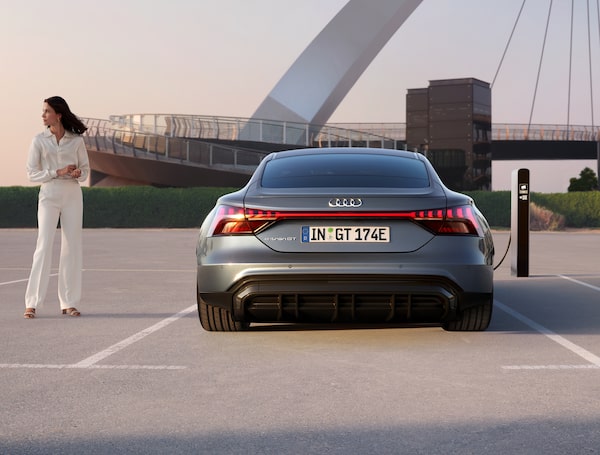The all-electric
Audi e-tron GT
is part of a more sustainable future
European model shown.
With plans to have 30 per cent of its portfolio electrified, including BEV and PHEV models by 2025 Audi is in the midst of a major transformation. Spurred by new technologies and growing EV infrastructure, this shift is part of Audi’s commitment to building a more sustainable future.
“Sustainability isn’t a trendy topic that will just disappear from the agenda at some point. It’s decisive for everyone’s future,” says Hildegard Wortmann, board member for sales and marketing at AUDI AG.
At the forefront of Audi’s efforts to reduce its environmental footprint is its “Mission Zero” program, which incorporates a variety of new measures into the production process, with a focus on decarbonization, resource efficiency, biodiversity and water conservation. Audi also has ambitious plans to make all of its manufacturing facilities carbon-neutral by 2025.
This transition is well underway at Audi’s Böllinger Höfe manufacturing site in Germany, where sustainable, smart factory technology is already being used to build new electric vehicles.
“With 100 percent eco-electricity and heat from regenerative sources, production is net carbon-neutral at Audi’s Böllinger Höfe site, which produces the exciting new Audi e-tron GT model family,” says Jason Santos, product manager at Audi Canada.

European model shown.SUPPLIED
At the Böllinger Höfe site, the manufacturing process is environmentally friendly and unique, relying on digitization, virtual reality and other advanced technologies to cut down on waste. These are strengthened by innovative initiatives such as a maintenance app, which eliminates the need for conventional, hand-written records, thereby saving paper and packaging. The facility also employs a closed-loop system that contributes to the reduction of several thousand metric tons of CO2 emissions each year by returning aluminum sheet offcuts to the supplier, where they are recycled and then reused again at Audi.
As important as these advances are, they are far from the only ways Audi is innovating to conserve raw materials. The Audi e-tron GT is also the first Audi produced entirely without any physical prototypes, with all assembly sequences tested virtually using software developed in-house. It’s a faster and more efficient way to work, but more importantly it’s a more environmentally friendly way to build a vehicle. The Audi Environmental Foundation, meanwhile, in collaboration with municipalities and EU’s LEADER support program, is helping to fund a study into the greenhouse gas offsetting capacity of peatland, woodland and humus ecosystems. Thanks to their high content of organic matter, these ecosystems are highly efficient carbon stores and are capable of storing more carbon dioxide than woodland over an equivalent area. The study also aims to outline how regional farmers can repurpose their land for alternative uses and be financially rewarded for their efforts.
“Sustainability isn’t a trendy topic that will just disappear from the agenda at some point. It’s decisive for everyone’s future”
In addition to its unique approach to energy usage, closed-loop recycling systems and digital prototyping, the Böllinger Höfe site is further improved by another important innovation: the ability to build two very distinct vehicles side-by-side. “This is one of the few places where a manufacturer can build an internal combustion-powered car and an electric car on the same line,” says Felix Enciso, director of product planning at Audi Canada. Building the Audi e-tron GT and Audi RS e-tron GT alongside the V-10-powered mid-engine Audi R8 high-performance sports car is another way to increase efficiency while decreasing waste. “With mass manufacturing, this is not possible,” says Enciso. “But since they are low-volume, and both use aluminum, high-strength steel and the same assembly process, Audi can build both together.”
The all-electric Audi e-tron GT has helped to transform the Böllinger Höfe facility into a manufacturing marvel of high technology and sustainability and provides a glimpse at a greener way of building cars. This, however, is just the beginning of Audi’s mission to create a more sustainable future through innovation.
https://www.audi.ca/ca/web/en/models/e-tron-gt/e-tron-gt-family.html
Advertising feature produced by Globe Content Studio with Audi. The Globe’s editorial department was not involved.